Breaking Down The Seahawks' Rushing Attack
The Seattle Seahawks set a franchise record with 350 yards rushing during their 38-17 victory over the New York Giants last week. It wasn't just a few chunk plays making up a majority of this yardage, either; Seattle was able to consistently rip off gains of 5+ yards on most of their carries, with a few more explosive runs in there too.
This is the type of style Pete Carroll wanted when Seattle acquired Marshawn Lynch in 2010, and the organization has wanted to maintain that identity even after finding the dynamic Russell Wilson in the draft two years later. This game is why, in their search for offensive linemen, the Seahawks have largely sacrificed pass protection ability to instead seek out guys who typify hard-nosed, downhill, run blocking maulers.
Take the right side of the offensive line, for example. J.R. Sweezy and Justin Britt aren't known for their surpreme footwork in pass protection and shutting down opposing pass rushers one-on-one (although Britt has been reasonable in this area this year, especially for a rookie). Hell, Sweezy was playing defensive tackle at NC State four years ago, and is brutal to watch in pass protection at times.
But what these two lack in ballet-like footwork in their pass protection sets going backwards, they make up for in athleticism and nastiness going forward in run blocking. Check out the right guard and the right tackle run out in front of Marshawn Lynch all the way downfield.
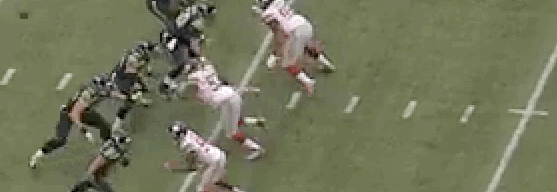
Not many dudes that big can do that at an NFL level, and the fact that this play was called to their side shows what the coaching staff thinks of them, too.
As with most things in the game of football, there wasn't just one reason for the Seahawks dominating rushing performance. A combination of excellent execution by Seattle and poor play by New York resulted in Seattle's excellent game, to put it in extremely general terms. Russell Wilson had over 100 yards rushing too, and plays like the ones I'm about to show you were almost comical in how poorly the Giants played defense against his rushing threat.
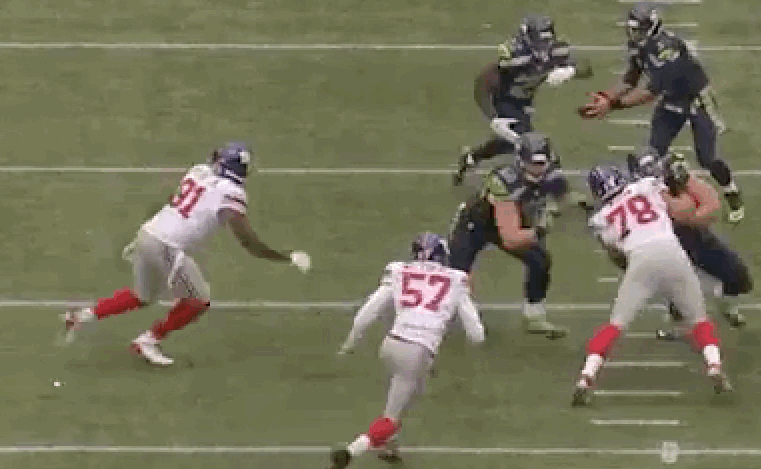
Seattle is running the zone-read option here, where Wilson can either choose to hand the ball off to the running back or keep it himself depending on the actions of the defenders. The Giants mess this one up badly when both Robert Ayers (91) and Jacquian Williams (57) crash down inside to defend the running back, and Wilson simply keeps it and runs to the open space on the edge.
The same exact thing happens in this next example, except it's two different Giants making the same mistake.
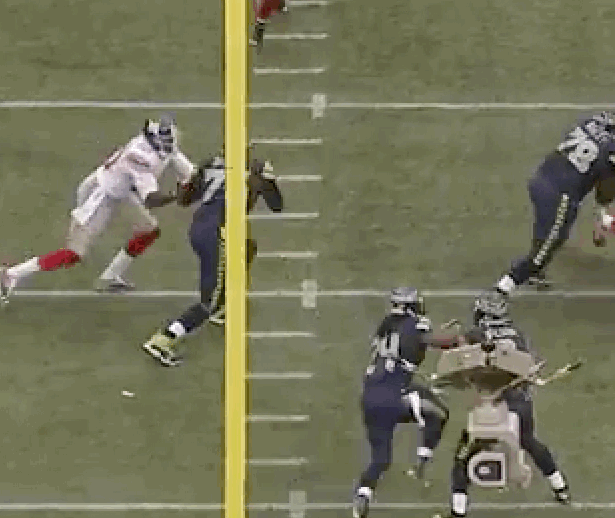
This time it's Jason Pierre-Paul (90) and Stevie Brown (27) who both take Lynch, leaving a wide-open lane for Wilson. Too easy for someone as good as Wilson is at being smart with the football.
And one more example:
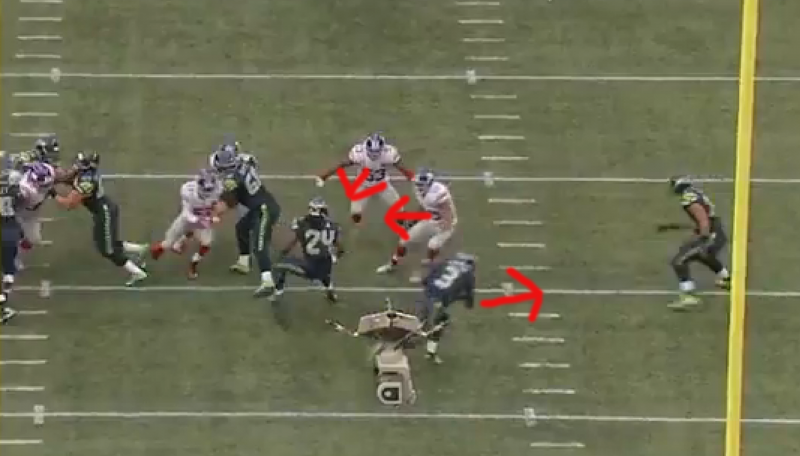
These are only three instances, but there were many more where New York committed both defenders in the area to either the quarterback or the running back, when they should have deployed one to each. It's simple assignment football, and Giants defensive coordinator Perry Fewell should be embarrased by how bad his defense looked preparation-wise in this matchup.
While we're on the subject, let's just get all of the Giants' screwups out of the way.
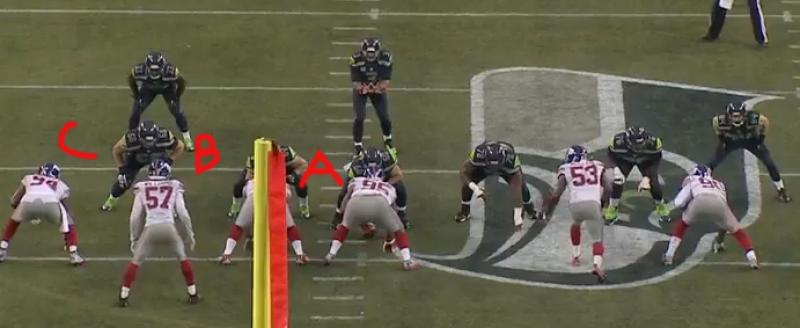
For those of you who don't know, the space in between each offensive lineman is called a "gap," and each one has a name corresponding to a letter of the alphabet, as labeled above. The defense's goal when defending the run is to defend every gap so the runner doesn't have anywhere to run through.
NYG's defensive line comes out in a funky-lookin' alignment here, with both inside defensive tackles playing head-up on the center and right guard respectively, which is something you usually don't see. But as long as every gap is covered post-snap, it really doesn't matter where the defensive linemen line up. But what happens post-snap suggests somebody screwed up:
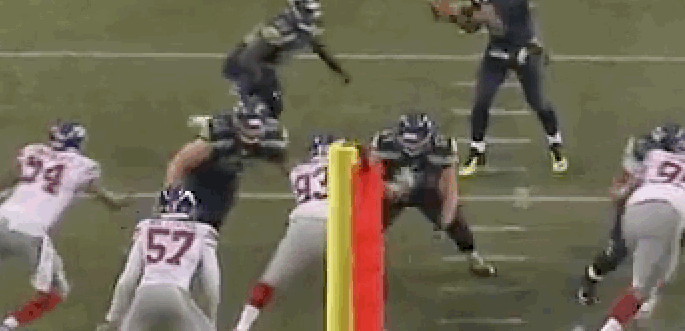
The defensive tackles (93 and 95) slant away from each other, leaving the A gap in between them wide open, and Mike Patterson (93) and Jacquian Williams (57) look like they're both trying to defend the B gap. Either that, or Williams is jumping outside along with Mathias Kiwanuka (94) to try to defend the zone-read option, in which case nobody accounts for the running back. Or something. Whatever it is they're trying to do, they leave the A gap completely undefended, and Wilson simply hands off to running back Christine Michael, who rips off a 45-yard gain through that very gap.
The Giants screwed up pretty badly at times, but it was still up to the Seahawks to execute and make the plays that they did. But now it's time for some talk about what Seattle did well.
As most or some of you probably know, Seattle largely runs a zone-blocking running system. This entails a lot of lateral movement by the offensive line, and a lot of cut blocking to try to get defenders out of their gaps.
There's a really cool article on zone blocking here, but I'll try to simplify it by taking a quote from zone-blocking master Alex Gibbs talking about the responsibilities of offensive linemen in the zone blocking scheme:
"If you are UNCOVERED, zone with your teammate to the playside. If you are COVERED, look at your backside (away from playside) teammate. If he is COVERED, you will block your defender man-on-man. If he is UNCOVERED, he will double team/combo block with you towards the LB."
Simple enough, right? But this still isn't always an exact science, and offensive linemen often react differently depending on what happens post-snap. I'll diagram it out on one of Seattle's many successful running plays:
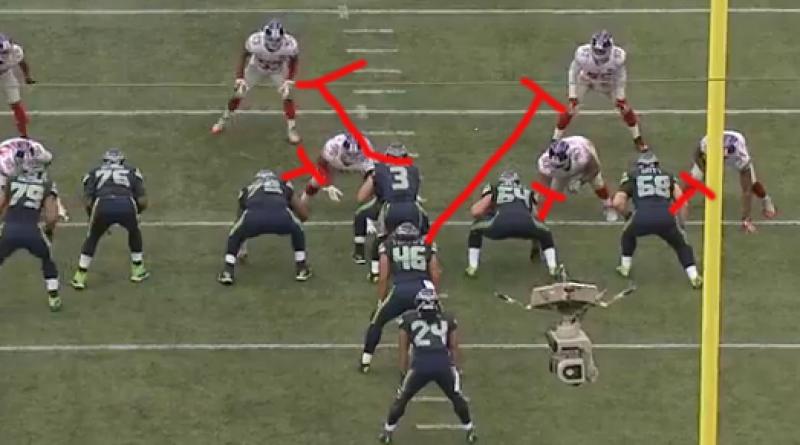
In this above image, the playside is the right side, since that's where Marshawn is supposed to run. Since both Britt and Sweezy (68 and 64) are "covered" by defenders to the playside, their job is to block them one-on-one. Since left guard Alvin Bailey (78) is covered and center Max Unger (60) is not, Unger's job is to help out Sweezy at first and them get to the second level to block linebacker Jameel McClain (53). That leaves Seahawks fullback Will Tukuafu (46) to block Jacquian Williams (57).
That's all fine and dandy on paper, but things don't exactly go according to plan after the snap.

The Giants call a defensive line slant inside (to the offense's left), which makes it easy for Britt (68) to seal the edge, but it also keeps the center Unger (60) from climbing to the second level to block the linebacker. This leaves the linebacker (53) completely unblocked, and he has a clear lane to make the tackle. But thankfully for the Seahawks, Marshawn Lynch is their running back, and Marshawn Lynch will rip the beating heart from your chest and eat it for breakfast. He trucks the unblocked linebacker, breaking the tackle easily before rumbling for a gain of 19. This is a prime example of how Lynch covers up for so many errors and can still carry an offense even when everything doesn't go exactly to plan.
More zone blocking:
This play is designed to go to the offensive left side, so going back to Gibbs' set of rules, left tackle Russell Okung and left guard Alvin Bailey will initially double-team the right defensive end, with Bailey climbing to the second level to block the linebacker (53). That means center Max Unger will be responsible for the one-technique defensive tackle (95) all by himself, while the right guard will initially help out the right tackle before climbing to pick up the other linebacker (57).
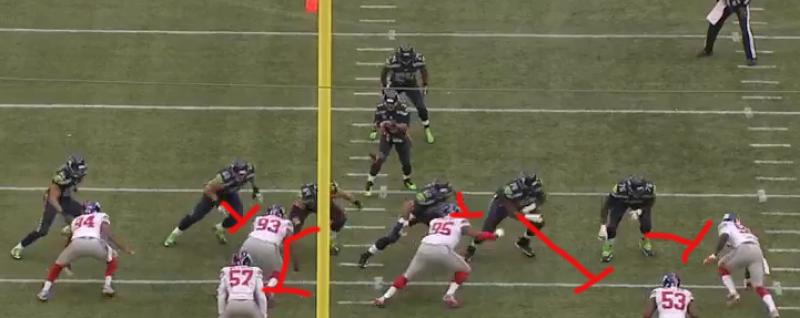
Yup, looks like everything is going to plan so far!

Then, a couple unexpected things happen:

First of all, linebacker Jameel McClain (53) comes down to contain the edge on the defensive right side, so the left tackle picks him up instead of the left guard, while the left guard stays on the block of Pierre-Paul (90). Nice job adjusting to changes on the fly from the left side of the offensive line.
The right side didn't fare so well. Sweezy got up to block the other linebacker (57), but defensive tackle (93, obscured from view by 57) beat the right tackle to the playside--the right tackle missed the block he was at least partially responsible for.
By the way, center Max Unger did a phenomenal job "reach-blocking" the defensive tackle (95) here. The tackle lined up "shaded" to the playside of Unger, yet Unger was still able to cross his face and seal the defender off (look how Unger walls 95 off from the play) one-on-one. Unger had a really good game overall.
It should also be mentioned that tight end Luke Willson is a pretty good blocker in spite of his "receiving tight end" label, and had a really good game in both pass and run blocking. Here you can see him cut-blocking the defensive end to the ground on the far left side of the screen.
Also, look at that insane cutback from Marshawn Lynch in the above image between the center and the left guard. Damn.
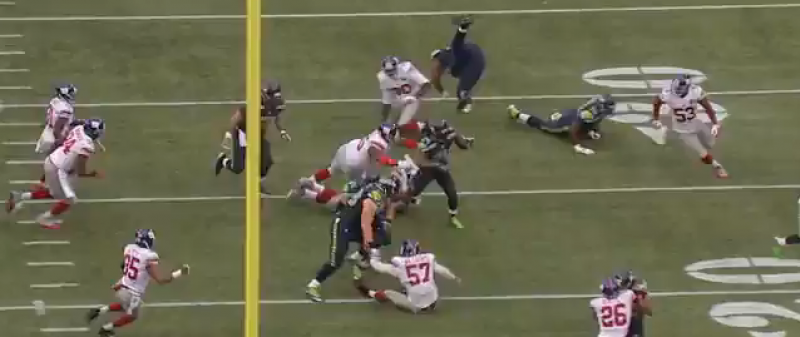
So anyway, pretty much everyone does their job except for the right tackle Britt, who wasn't able to seal Patterson (93). That leaves Patterson with a free shot at tackle Lynch from behind right here (Patterson is diving at Lynch's legs from behind in the above image), but again, Lynch is not a nice man. He breaks Patterson's tackle easily and rumbles for a gain of 21 as he again makes up for an unblocked defender. By the way, look how Sweezy puts Williams (57) on his ass right here. That's some good football.
This next example is a play Seattle almost had won before the snap. They have four blockers (center, left guard, left tackle, fullback) for four defenders (d-tackle, d-end, linebacker, and safety) on the offensive left side. This is another zone blocking play, which means that the center will get some initial help from the left guard.
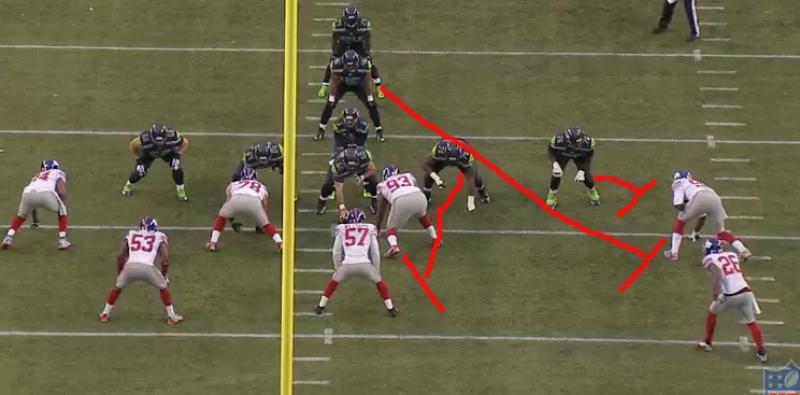
All goes according to plan thus far:

The left guard smoothly gets up to the second level and picks up the linebacker (57), while the center beautifully walls off the defensive tackle (93):

The fullback (46) takes care of the safety nicely, leaving a clear alley for Lynch to run through below. Great blocks from Seattle, and the Giants couldn't shed any of them here. It should also be noted that right guard Sweezy put a hit on the linebacker (53) that didn't get him to the ground, but knocked him off course long enough for Lynch to get to the second level untouched before 53 could slide over:

Beautifully done.
Seattle also used quite a bit of six-offensive linemen sets in this game, bringing in Garry Gilliam (79) as an extra tackle on 33% of their offensive snaps. This method was quite effective in the run game, and here's Gilliam demolishing the defensive end and collapsing the edge on one of Lynch's four touchdown runs.
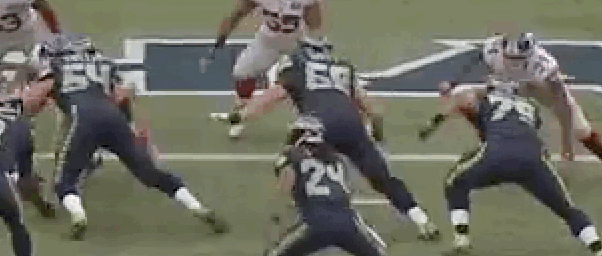
Before we go, I'd like to touch on Seattle's passing game. It's not good right now. The perception is out there that it is largely the fault of Seattle's receivers for not creating enough separation, but in reality, a lot of it is on Russell Wilson. He just hasn't been accurate--he missed at least two opportunities for touchdown passes last week alone. Like this one to Paul Richardson:
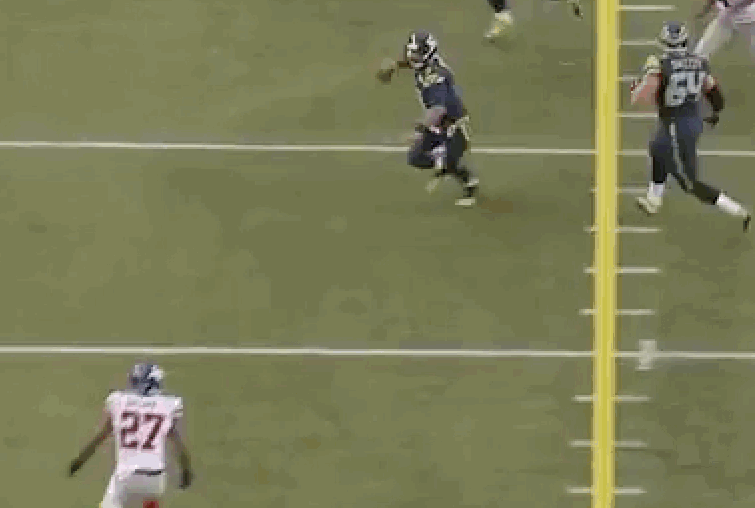
Richardson has the linebacker beaten by a couple steps and is running to space here, and Wilson throws this ball behind his receiver and into the dirt. Brutal.
And another throw that should have been six:

Wilson had Jermaine Kearse open by two or three steps on a designed deep shot, and overthrew him badly. This is tougher throw than the first one I showed, but still one that Wilson should make most of the time.
Honestly, Seattle's receivers may not be well-known, but that doesn't mean they aren't good. They won't have notable numbers because of the way the Seahawks play offense, but Golden Tate's production this year in Detroit shows that a receiver's numbers don't always correspond with how good of a player he is (remember last year when people criticized Tate and Seattle's receiving corps for being "pedestrian"?). Seattle's receivers are actually quite athletic and talented, with speedsters like Ricardo Lockette and the aforementioned Richardson in addition to Kearse and the shifty Doug Baldwin. They should have no problems getting open.
I believe the problem has rather been more of a combination of play calls/route designs and poor accuracy from Russell Wilson (that's a whole 'nother article), but I think both things (especially the latter) has the potential to get better in coming weeks. Check out this brilliant throw from Wilson:
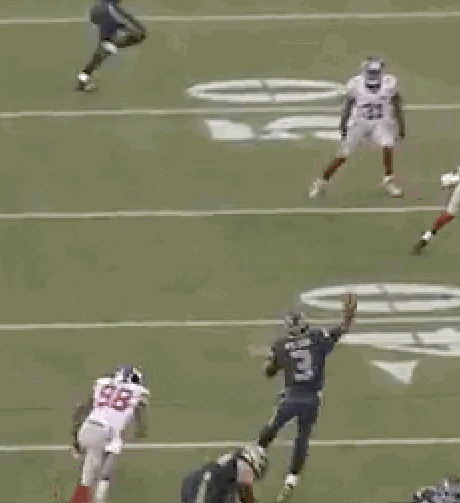
He leads Kearse down the sideline and anticipates his movement deep, throwing the ball before Kearse is even turned around. That's an example of what Wilson can do when he's on, and that's as good of a throw as you'll see on Sundays.
The Seahawks' rushing attack won't face an undisciplined team like the Giants every week, but the good news is they still have Marshawn Lynch. They will need the passing game to pick up though, and that's largely on Russell Wilson. If they can put it all together, they can be one of the top well-rounded offensive attacks in the league.
Follow Staff Reporter Andrew McKagan here.



